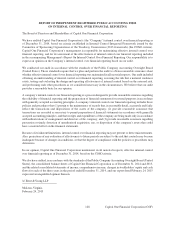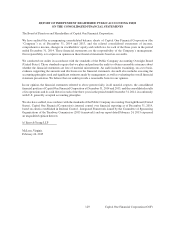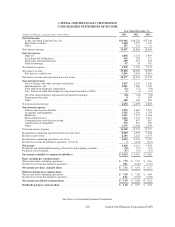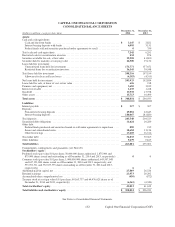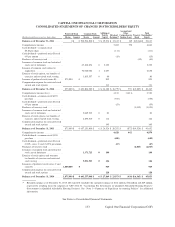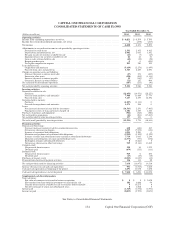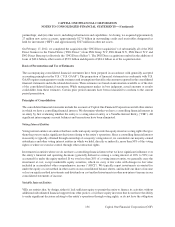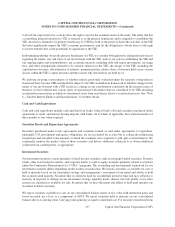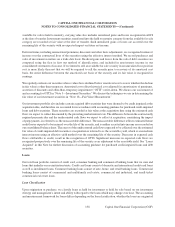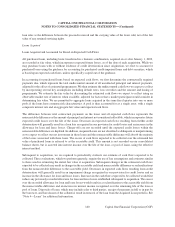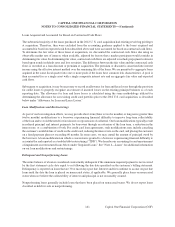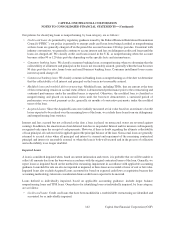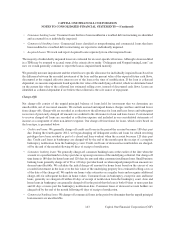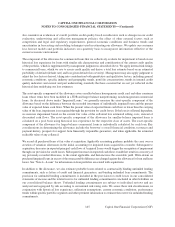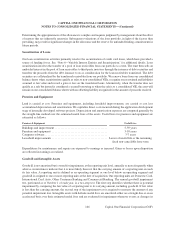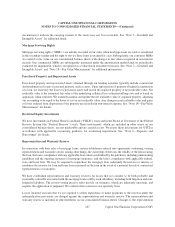Capital One 2014 Annual Report Download - page 159
Download and view the complete annual report
Please find page 159 of the 2014 Capital One annual report below. You can navigate through the pages in the report by either clicking on the pages listed below, or by using the keyword search tool below to find specific information within the annual report.137
to absorb the expected losses, or do not have the right to receive the residual returns of the entity. The entity that has
a controlling financial interest in a VIE is referred to as the primary beneficiary and is required to consolidate the
VIE. An entity is deemed to be primary beneficiary if a VIE has both (i) the power to direct the activities of the VIE
that most significantly impact the VIE’s economic performance; and (ii) the obligation to absorb losses or the right
to receive benefits that could potentially be significant to the VIE.
In determining whether we are the primary beneficiary of a VIE, we consider both qualitative and quantitative factors
regarding the nature, size and form of our involvement with the VIE, such as our role in establishing the VIE and
our ongoing rights and responsibilities; our economic interests, including debt and equity investments, servicing
fees, and other arrangements deemed to be variable interests in the VIE; the design of the VIE, including the
capitalization structure, subordination of interests, payment priority, relative share of interests held across various
classes within the VIE’s capital structure and the reasons why the interests are held by us.
We perform on-going reassessments of whether entities previously evaluated under the majority voting-interest
framework have become VIEs and should be subject to the VIE consolidation framework or whether changes in the
nature of our involvement with a VIE results in a change in our consolidation conclusion. In the normal course of
business, we have entered into various types of transactions with entities that are considered to be VIEs including
securitization transactions in which we transferred assets from our balance sheet to securitization trusts. See “Note
6—Variable Interest Entities and Securitizations” for further details.
Cash and Cash Equivalents
Cash and cash equivalents include cash and due from banks, federal funds sold and securities purchased under
agreements to resell, and interest-bearing deposits with banks, all of which, if applicable, have stated maturities of
three months or less when acquired.
Securities Resale and Repurchase Agreements
Securities purchased under resale agreements and securities loaned or sold under agreements to repurchase,
principally U.S. government and agency obligations, are not accounted for as sales but as collateralized financing
transactions and recorded at the amounts at which the securities were acquired or sold, plus accrued interest. We
continually monitor the market value of these securities and deliver additional collateral to or obtain additional
collateral from counterparties, as appropriate.
Investment Securities
Our investment securities consist primarily of fixed-income securities, such as mortgage-backed securities, Treasury
bonds, other asset-backed securities, and corporate bonds, as well as equity securities primarily related to activities
under the Community Reinvestment Act (“CRA”) programs. The accounting and measurement framework for our
investment securities differs depending on the security classification. We classify securities as available for sale or
held to maturity based on our investment strategy and management’s assessment of our intent and ability to hold
the securities until maturity. Securities that we intend to hold for an indefinite period of time and may sell prior to
maturity in response to changes in our investment strategy, liquidity needs, interest rate risk profile or for other
reasons are classified as available for sale. Securities that we have the intent and ability to hold until maturity are
classified as held to maturity.
We report securities available for sale on our consolidated balance sheets at fair value with unrealized gains and
losses recorded, net of tax, as a component of AOCI. We report securities held to maturity on our consolidated
balance sheets at carrying value. Carrying value generally is equal to amortized cost. For securities transferred from
CAPITAL ONE FINANCIAL CORPORATION
NOTES TO CONSOLIDATED FINANCIAL STATEMENTS—(Continued)
Capital One Financial Corporation (COF)



